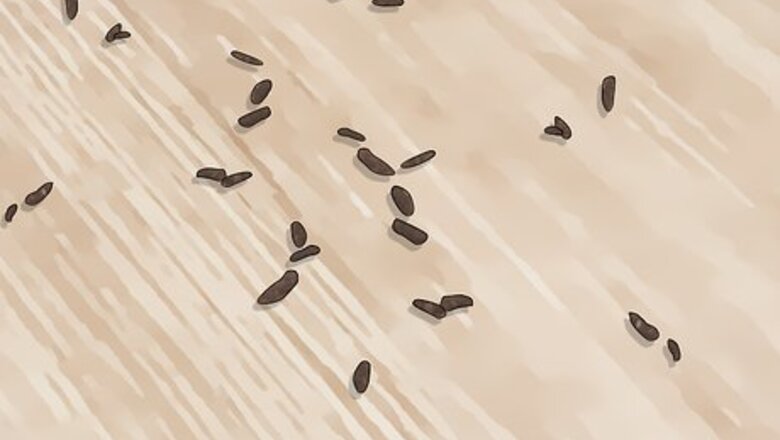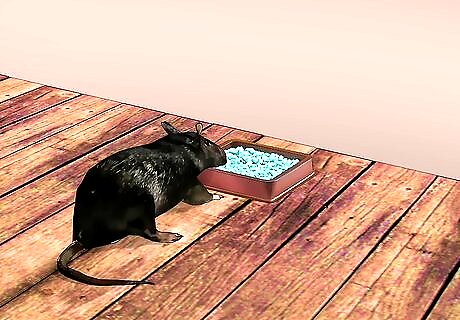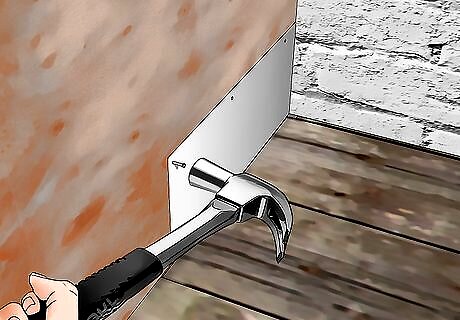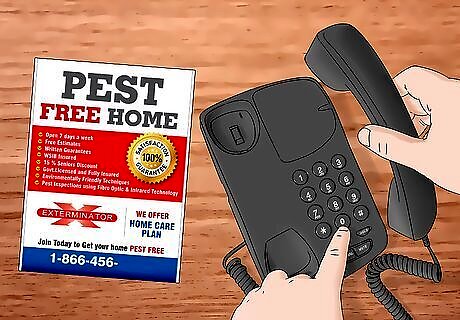
views
Setting Traps

Look for tracks and other signs showing rat activity. Before setting out traps, determine where the rats are most active. Rat droppings are one of the main signs to look for—they're usually around ⁄4 in (1.9 cm) long and they'll show up wherever the rats have been. Also, spot any parts of the attic the rats have been gnawing on. Rats tend to travel back and forth across areas they know are safe, so you can catch them by putting traps in their paths. Rats often chew on wood and insulation, especially along the floor. Also, note any holes in the wall and roof. If any part of your attic is dusty, you may be able to spot tracks left behind by the rats.

Set plenty of traps close to where the rats normally roam. Place them along the paths the rats take through your attic. While the rats are active, they will stumble upon the traps and eventually end up in them. Try positioning a few traps near openings in the wall, close to where you see tracks or droppings, and behind furniture. For a better chance at catching the rats, set up lots of traps. If you’re only dealing with a handful of rats, you could set out a dozen traps. If you’re dealing with an infestation, set out up to 3 dozen traps. Snap traps are ideal since they are effective and reusable. Position them so they are perpendicular to the wall. Rats often stick close to walls and will have to step on the traps as they scurry around.

Bait the trap with peanut butter or another nutritious food. Forget what you saw in the cartoons. Instead of cheese, get bait like nuts and berries. Roof rats, the species most likely visiting your attic, like plant-based foods. They may also be drawn by bacon and food scraps. Wear gloves when baiting traps so you don’t leave your own tracks on them. Place a little bit of bait on the trap. For example, spread a teaspoon (5 g) of peanut butter or less. Alternatively, place a small piece of dried fruit or a nut in the trap. If you’re baiting a trap with something solid, such as dried fruit, consider trying it to the trap. That way, the rats can’t just pick it up and run away. They have to walk into the trap to get it.

Check back every day until you see a rat in the trap. Rats are pretty cautious, so you probably won’t catch anything right away. Give them 2 or 3 days to get accustomed to the traps. If the traps are along their usual routes, they will eventually have to travel past them. You should then see sprung traps with stuck rats. To get rats accustomed to seeing the traps, try placing a few unset traps first. After a couple of days, the rats will feel safe enough to walk on the traps. Set the traps afterward to catch them.

Dispose of the rats and replace the traps. Put on a pair of rubber gloves before handling the trap. You can place dead rats inside a trash bag, but keep it closed and covered until you are able to get rid of it. Then, wash your hands and the traps with soap and water. Most traps are reusable, so put them back out if you still have more rats to get rid of. Continue looking for tracks and other signs of rats in your attic. Also, listen for squeaking or scratching coming from the walls.
Selecting a Trap Type

Pick snap traps for a simple but efficient way to eliminate rats. Snap traps are quick, lethal, and inexpensive. They come in different sizes, so make sure you get ones made for rats instead of mice. There are standard wood traps with a metal bar as well as heavy-duty alligator-style traps made from plastic. Both styles can be cleaned and reused. When set correctly, these traps are humane because they kill instantly. Rats can be more than twice as big as mice, so they shrug off traps meant for mice. Mouse traps are way too small to be effective.

Get electric traps for another humane alternative to killing rats. Electric traps are a cross between cage and snap traps. Rats enter the big box, get zapped by an electric charge, and die instantly. These traps tend to be pretty bulky and expensive compared to other types of traps, so they don’t work as well in tight quarters. Save them for more open areas, placing them along the attic walls with a little bit of bait. Like snap and cage traps, electric traps are reusable and easy to clean. Finding rat-sized electric traps can be difficult. Electric traps are mostly used for mice, although you can still find some for rats.

Place glue traps in tight areas if you need them. Glue traps keep rats stuck in place until they die. The traps have to be placed where the rats are likely to scamper. Some good places to put these traps include underneath furniture and behind boxes. The traps are bigger than snap traps but don’t necessarily work as well. Glue traps are pretty inhumane. Once the rat gets stuck, it can’t leave. It may attempt to chew off its foot when it begins to starve. The advantage of a glue trap is that it is easy to place and can be thrown away after use. However, strong rats can break out. Make sure you’re using a strong trap meant for rats, not mice.

Lay out a poison trap as a last resort. Poison traps make use of a toxic bait. Once a rat eats the bait, it dies within a couple of days. You can then place the rat and the remaining bait in a garbage bag. For safety, get a tamper-proof bait station to house the bait. Poison traps usually aren’t ideal and may be legally regulated in your area. They can be dangerous to children, pets, and other animals. One downside of poison baits is that they aren’t instantaneous. The rat will live for a while. It may crawl into a hidden spot, like your wall, and begin decaying before you find it.

Choose a cage trap if you wish to catch and release rats. If you’re determined not to harm any of your attic’s visitors, cage traps may be worth looking into, depending on where you live. As soon as the rat enters the trap, the cage door slams closed. After putting on a pair of gloves, you can then take the cage outside to release the rat. Open it at least 3 to 5 mi (4.8 to 8.0 km) away from your home so the rat can’t find its way back. Be sure to release the rat in a wooded area with a lot of hiding spots. If you can, do it in the evening, since rats don’t see well in daylight. Note that rats need warm shelters to survive. If you release it into the rain, snow, or cold weather, it could die unless it finds a new shelter. Trapping and relocating live animals is illegal in many areas, so contact your local State Agriculture or Fish and Wildlife Department to see if this is allowed where you live.
Protecting Your Attic from Rats

Inspect your home for gaps allowing rats to get inside. Set a ladder outside so you can climb up and get a clear view of your attic and roof. Check vents and chimneys to see if they are open or covered. Next, look for small holes in the siding and between the roof and the walls. Mark these spots as needed so you can fix them later. Although rats are bigger than mice, they are still capable of squeezing through very holes as small as 0.75 in (1.9 cm) in diameter. Every opening has to be covered to prevent infestations. Also, check whether there's a gap between the top of your gutter and the bottom of the shingles. This can provide the rats with an entryway into your home.

Seal off gaps with metal covers and caulk. Cap your chimney with a metal cover, then position grates over vents and other openings. Fill in cracks and small holes with a silicone caulk. Using a caulk gun, squeeze caulk from the bottle until each gap is completely filled. You can also caulk and cover gaps inside your home for additional protection. For the best result, deal with gaps before you start setting rat traps. Without the gaps, the rats can’t get outside and will be more likely to walk into the traps. Gaps have to be filled so that more rats can’t get inside.

Cut back trees and vines near your attic. Roof rats climb up trees and tall structures to get into your home. Prune trees and bushes by cutting off old branches. Make sure they are 6 ft (1.8 m) or more from your home. Also, pull down any vines growing on your home or nearby walls. You can’t really do anything with walls and other tall structures, so improvise. Try placing small, enclosed traps near your attic in case any rats climb up there.

Call an exterminator if you need help dealing with an infestation. For the most part, you can take care of any rats in your attic through careful planning and determination. If you’re not having any luck, let a professional lay down some traps. They will also identify how the rats are getting into your attic and provide recommendations for keeping them out. This is a good option for consistent pests you just can’t seem to get rid of. Many exterminators depend on poison traps, which many not be the best or most efficient solution. Before hiring an exterminator, discuss how they plan on dealing with the problem. Extermination services cost much more than the basic traps you can buy and set up on your own. One visit may cost up to $300 USD.



















Comments
0 comment